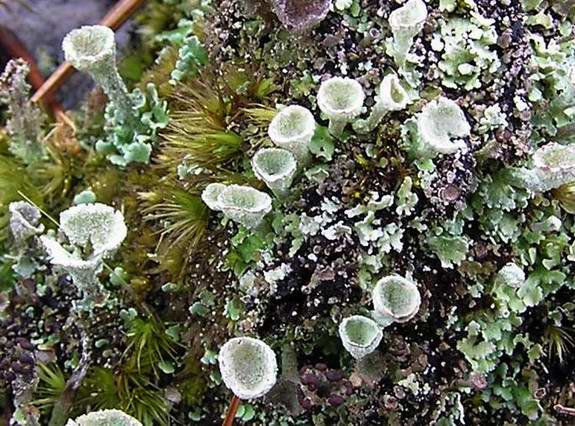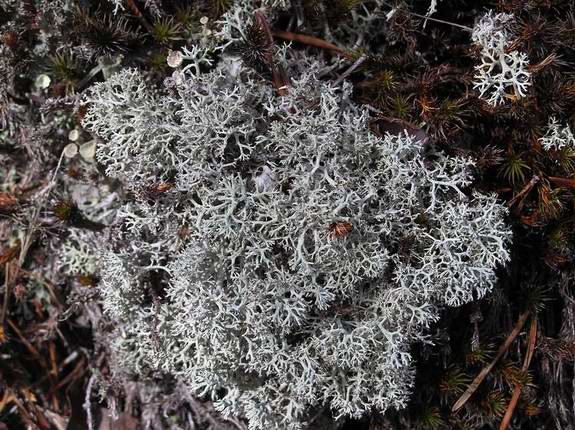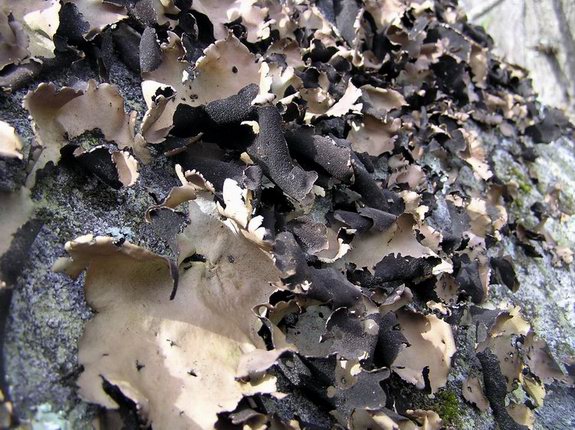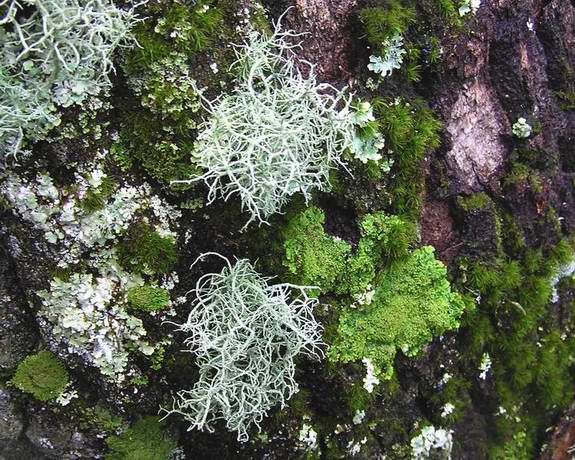
Lichens
A lichen is "an association of a fungus and a photosynthetic symbiont resulting in a stable vegetative body having a specific structure" according to the definition accepted by the International Association of Lichenologists. On a lighter note, a lichen has been called a "fungus that discovered agriculture." The fungus provides structural stability, water and minerals and the alga provides complex carbohydrates. This close mutual relationship allows lichens to occupy extremely adverse environmental habitats that range from isolated rock outcrops in the frigid rarefied atmosphere at elevations over 6,000 meters to arid deserts devoid of virtually any other sign of life. Globally, there are about 14,000 species of lichens; 3,600 species are in North America.

In the most generalized sense, lichens are divided into five categories according to their basic morphology: crustose, foliose, fruticose, squalmulose and leprose. Crustose lichens are the most familiar, as they are the tightly adherent crust-like growths typically found on any relatively old stone surface like a grave marker. Foliose and fruticose are the lichens that look like little leaves (folium is the Latin word for leaf) or little shrubs (frutex is the Latin word for shrub and has nothing to do with fruit). The last two are essentially variants of the crustose variety; squamulose lichens are crust-like with upturned scales (a squama is a scale) and leprose lichens are crust-like with a loose powdery surface. There are also combinations of these basic types; most species of the genus Cladonia, such as the pebbled pixie cup lichen (C. pyxidata) -pictured at right, and the British soldier lichen (C. cristatella) are squamulose-fruticose, as cone-like fruticose protuberances extend from the scaly squamulose substrate.
The basic functional structure of a lichen is relatively simple. The fungal portion, called the mycobiont, constitutes the bulk of the thallus, or vegetative body; the algal component, or photobiont provides the photosynthetic energy. This relationship is generally characterized as benign mutualism, a type of symbiosis in which both constituents share the benefits of the association. However, it is probably better to characterize the relationship as at least partially parasitic, for in virtually every case the fungus penetrates the alga and absorbs about half of its nutrients; the survival of the lichen depends on the alga replenishing lost cells through photosynthesis. However it may be characterized, the lichen relationship is very successful; there are about 20,000 species of fungi that exist only as lichens, about 20 percent of the known fungi population. None are found without their symbiotic partner in the natural environment, though they can be produced in the laboratory when isolated under axenic conditions.
Almost all of the lichenized fungi are in the subphylum Ascomycotina; the ascomycetes are called cup fungi because their spores are contained in a structure called an ascus that is typically shaped like a cup. There are 12 orders in Ascomycotina that are almost wholly comprised of lichen-forming fungi. Only two percent of lichenized fungi are in the subphylum Basidiomycotina; the basidiomycetes include the umbrella-shaped gilled fungi more generally called mushrooms. In either case, the body or thallus of the lichen is divided into four distinct layers, three fungal and one algal. The top layer is called the upper cortex and consists of tightly packed fungal filaments called hyphae that protect the lichen from the environment and may be pigmented to shield against specific damaging light spectra. The algal layer is just under the upper cortex and is permeated by the hyphae of the third layer (medulla) which is comprised of loosely woven hyphal threads. The lower cortex is the bottom layer with specialized structures called rhizines that attach to almost the substrate that the particular lichen species is adapted to including rock, tree bark and soil.
Unlike the diversified mycobiont associates, 90 percent of all photobionts come from only three genera, Trebouxia, a unicellular green alga genus, Trentepohlia, a filamentous green alga and Nostoc, a cyanobacterium. Cyanobacteria were once known as blue-green algae; general statements concerning "algal" lichen constituents are therefore semantically, if not technically correct. Relatively recent changes to taxonomy resulted in the transfer of the blue-green algae from the Plant Kingdom to the Eubacteria Kingdom, since they are really bacteria and not algae. Their taxonomy is not yet settled; bacteria are prokaryotes - they have no nucleus, a fact that distinguishes them from the eukaryotes, the cells of plants, animals and fungi that do have nuclei. Cyanobacteria do not have the chloroplasts that carry out the photosynthetic process for the green algae but rather have chlorophyll throughout the cell fluid; their chlorophyll manufactures glucose that is used by the fungus. Cyanobacteria also have the relatively rare ability of nitrogen fixation; they produce structures called heterocysts that synthesize nitrogenase, the enzyme that transforms the gaseous nitrogen in the air to the monatomic atom necessary for the growth of living cells. Lichens that have cyanobacteria as their photobiont can thus survive in environments devoid of any soil nutrients.
The flow of nutrients between the mycobiont and the photobiont is the essence of the quasi-parasitic relationship. The mycobionts have specialized structures called haustoria that penetrate the cells of the alga. In the photosynthetic process, the green alga photobionts produce sugar alcohols; Trentepohlia produce erythritol, Trebouxia produce ribitol and Nostoc produce glucose. These nutrients are transported to the fungal cell where they are turned into mannitol, a sugar alcohol widely found in fungi as a storage product. Because of the penetration of the algal cell by the fungus, the transport and conversion process occurs quite rapidly, often in under two minutes. It is also hypothesized that the alga provides vitamins to the fungus, notably biotin and thiamine. The role of the fungus in the relationship is not as well defined. It is highly efficient at absorbing water vapor from the air, so much so that at high humidity levels, the algae photosynthesize at nearly their maximum rate. The fungal component also synthesizes a number of unique organic compounds some of which are chelating agents that bind to metal atoms, thus providing a source of minerals to the alga.
Lichenized fungi produce spores in a manner that is essentially the same as non-lichen fungi, the ascomycetes produce ascospores in the asci and the basidiomycetes produce basidiospores on the basidia. The only essential difference is that the slow growth of the lichen results in slow spore maturation. The released spores face another difficulty - in order to become a lichen they need to find the appropriate alga with which to combine. Attempts to grow lichens with appropriate fungal spores and algae in the laboratory were unsuccessful until it was discovered that this could only be achieved when the two components were incubated in a low resource stressful environment - i.e. when the fungus and the alga needed each other to survive. There is a low likelihood of lichen synthesis under natural conditions due to the paucity of the spores and a concomitant low probability of an encounter with a complimentary alga. The ubiquity of lichens cannot be therefore explained according to normal sexual regeneration. Not surprisingly, opportunistic lichens evolved vegetative regeneration, a form of asexual reproduction in which portions of the existing growth (vegetation) provide the genetics for replication. However, rather than a piece of the lichen thallus (containing both algal and fungal cells) breaking off and starting a new growth, it is more common for the lichen to form specialized structures that contain undifferentiated cells of each constituent. There are a number of different vegetative reproductive structures that are employed to this end: soredia consist of tangled hyphal strands that enclose several algal cells; isidia are extensions of the lichen thallus that can be cylindrical, spherical, or branched; schizidia are flakes that detach from the surface of the thallus; lobules are rounded lobes that form on the edges of the thallus. In every case, the fungus and the alga are transported together to a new location where, if environmental conditions are favorable (which means unfavorable to other competing species like moss), they will form a new colony.
 Lichens
are with good reason considered the ultimate pioneer plants; their ability to
establish colonies in stark habitats a direct result of their evolved tolerance
of xeric conditions, their self sufficiency in carbohydrate, and, in some cases,
nitrogen resources, and their adaptive method of vegetative regeneration. Though
lichens are of marginal ecological importance in temperate regions, they provide
up to 90 percent of the ground cover in northern boreal forests, which comprise
about 8 percent of the earth's land surface area. Lichens are an important food
source for a number of northern ranging animals, most notably reindeer (or, as
they are known in North America, caribou), whose dependence on the aptly named
reindeer lichen (primarily Cladonia
rangiferina and Cladonia stellaris) is such that it comprises about
90 percent of their winter diet and 50 percent of their summer diet. The
arboreal lichens that are not subject to the overburden of winter snowfall are
major food sources many of other large northern mammals such as moose and
white-tailed deer. Even small mammals such a northern flying squirrels and
voles get a major portion of their nutrition from lichens.
Lichens
are with good reason considered the ultimate pioneer plants; their ability to
establish colonies in stark habitats a direct result of their evolved tolerance
of xeric conditions, their self sufficiency in carbohydrate, and, in some cases,
nitrogen resources, and their adaptive method of vegetative regeneration. Though
lichens are of marginal ecological importance in temperate regions, they provide
up to 90 percent of the ground cover in northern boreal forests, which comprise
about 8 percent of the earth's land surface area. Lichens are an important food
source for a number of northern ranging animals, most notably reindeer (or, as
they are known in North America, caribou), whose dependence on the aptly named
reindeer lichen (primarily Cladonia
rangiferina and Cladonia stellaris) is such that it comprises about
90 percent of their winter diet and 50 percent of their summer diet. The
arboreal lichens that are not subject to the overburden of winter snowfall are
major food sources many of other large northern mammals such as moose and
white-tailed deer. Even small mammals such a northern flying squirrels and
voles get a major portion of their nutrition from lichens.
From the human perspective,
lichens have a number of proven and potential applications that range from
their use as a food source of last resort to a consistent and valued constituent
of a normal diet. Rock tripe (Umbilicaria
mammulata) is probably the best known of the "survival lichens" on account
of the harrowing exploits of early explorers. Most notable was the fist
expedition of John Franklin to map out the Northwest passage through the
northern Canadian waters from 1819 to 1822. In the second year of the
exploration, the party of 20 was forced to return on foot when their two birch bark canoes became
damaged. Franklin's journal recorded the epic journey which has become one of
the epitomes of deprivation: "The tripe-de-roche, even where we got enough, only
serving to allay the pangs of hunger for a short time." Tripe-de-roche is the
Quebecois word for the lichen. However, rock tripe and other lichens have been
regularly eaten as a normal food by various indigenous peoples. For example,
the Cree used them as an additive to fish broth to make a thick soup that was
not only eaten for nutrition but was considered to be somewhat medicinal. On the
other side of the Atlantic, several types of lichen were used as starvation food
in Scandinavia and Russia during times of famine when the staple crops of
potatoes, beets and wheat were not available. Though speculative, it is
considered plausible that the "manna from heaven" that was provided to the
fleeing Israelites in the book of Exodus during their 40 year diaspora was a
desert lichen indigenous to northern Africa. It forms into balls that are driven
by the wind and swollen by morning dew to mysteriously appear in large clusters
as if divinely sent.
party of 20 was forced to return on foot when their two birch bark canoes became
damaged. Franklin's journal recorded the epic journey which has become one of
the epitomes of deprivation: "The tripe-de-roche, even where we got enough, only
serving to allay the pangs of hunger for a short time." Tripe-de-roche is the
Quebecois word for the lichen. However, rock tripe and other lichens have been
regularly eaten as a normal food by various indigenous peoples. For example,
the Cree used them as an additive to fish broth to make a thick soup that was
not only eaten for nutrition but was considered to be somewhat medicinal. On the
other side of the Atlantic, several types of lichen were used as starvation food
in Scandinavia and Russia during times of famine when the staple crops of
potatoes, beets and wheat were not available. Though speculative, it is
considered plausible that the "manna from heaven" that was provided to the
fleeing Israelites in the book of Exodus during their 40 year diaspora was a
desert lichen indigenous to northern Africa. It forms into balls that are driven
by the wind and swollen by morning dew to mysteriously appear in large clusters
as if divinely sent.
The biological diversity of lichens is reflected in their variegated chemistry that consists of over 200 unique compounds that have been extracted for a wide range of practical applications, including dyes, perfumes, medicines and poisons. Lichen dyes fall into two categories: boiling water dyes and fermentation dyes. The former are made by boiling the alternating layers of lichens and fiber for several hours necessary to effect the color transfer. The lichens used for this process, notably those from the genus Parmelia, are called crottle, which means kernel or rind in Gaelic; the crottle lichens were the source for the brown and yellow dyes used in the Scottish Harris Tweed fabrics. The fermentation dyes produced a much brighter red to purple hue, but only after the lichen was mixed with a source of ammonia, which, before the advent of chemical formulation, was urine collected for that purpose, and the fiber was fermented in the mixture for several weeks. Litmus paper, which is used to indicate PH (blue is basic or PH > 7 and pink is acidic, PH < 7), is made with lichens containing depside that dye the paper according to the acidity of the measured solution. In the perfume industry, lichens have been used for years due to their surfactant characteristics which serves to affix a fragrance to a surface; some lichens add a pleasant aroma of their own, a noted property of some esters which are the basis of their chemistry.

Lichens have been used for medicinal purposes for millennia. There general vulnerary characteristics led to their use in treatment of wounds and other antibiotic applications. During the 14th Century, the doctrine of signatures became popular and the list of lichen medicines grew according to their appearance. The belief among herbalists that was popularized by Paracelsus was that God provided a signature to man as to the use of a plant according to its structure and color. Thus, yellow lichens would be good for the treatment of a jaundiced liver and lichens shaped like a lung could be used to treat tuberculosis. Lichens of the genus Usnea, which are typically hair-like in appearance, were used to treat baldness. Surprisingly, some of the time the doctrine of signatures was correct, as the lichen known as the tree lungwort does, in fact, have a palliative effect for people suffering from lung diseases, and the lichens of the genus Usnea do have medicinal properties (that have nothing to do with baldness). Usnic acid has antibiotic properties and has been collected and used to make antibiotic creams and ointments in Europe since the 1950's. It has fallen out of favor in recent years owing to the allergen reaction in some people that results in a serious skin rash. However, usnic acid from lichens has been used to treat gynecological problems for centuries by cultures as diverse as the Chinese and the Ancient Greeks.
Lichens are very sensitive to the environment, as they derive almost all of their moisture from the air and they are long-lived with a slow growth rate. These two factors make them valuable as biological monitors of air quality and as biological clocks to date geological events. Lichens are particularly sensitive to sulphur dioxide, one of the primary constituents of acid rain, and, since some are more sensitive than others, a survey of lichens in a given area over time has been used to map pollution levels, notably in the British Isles. Since lichens absorb other pollutants much more efficiently than plants, they have also been collected and analyzed in the laboratory to detect for PCBs and the radioactive fallout from the Chernobyl reactor accident. Lichenometry is the "measurement of lichens" which uses the known growth rate of the lichen to measure the age of a surface. This process has been used to date earthquakes by determining the age of the lichens that grew on the newly exposed surface and to date anthropomorphic stone objects like the (450 year old) iconic Easter Island (Rapa Nui) moai statues.
Recent revelations about the origins of life on earth based on the fossil record have drawn attention to the humble lichen as a possible if not probable key link between the marine bacteria and algae of the Achaean Eon and their terrestrial successors of the Proterozoic Eon. According to the current prevailing theory, the earth was formed about 4.5 billion years ago (bya) by the accretion of matter in the orbit of the newly formed solar disk. The inferno of moldering magma that lasted for about 800 million years was named the Hadean Eon for the Greek god of the underworld. As the earth cooled, water condensed to form the oceans in the Archaean Eon, which lasted about 1.2 billion years. It was during this time that the fossil record of marine sediments posits the origin of life in the form of bacteria-like microbes called Archaebacteria; their recent discovery in the thermal vents of the separating mid-ocean tectonic plates further supports their provenance in the primordial oceans. The methane given off by the Archaebacteria and other early forms of bacteria gradually accumulated to form the first atmosphere. About 2.5 bya, things settled down into the Proterozoic, the longest of the four eons; it lasted about 2 billion years of which the central billion years are known as "the boring billion" because according to the fossil record, nothing happened. It ended with the so-called Cambrian explosion first postulated with the discovery of the Burgess Shale that marked the beginning of the current Phanerozoic Eon when complex eukaryote animal life first appeared about 543 million years ago. It may be that the Proterozoic Eon was long and boring to provide the necessary and sufficient chemical environment for complex life to form, and it is in this context that lichens may have played a critical role.
During the Archaean, archaebacteria first appeared, evolving into other forms of bacteria including the cyanobacteria. One of the more plausible theories for the evolution of plants and animals is that the chloroplasts that are the energy producers of plant cells and the mitochondria that are the energy producers of animal cells were bacteria that were absorbed by another type of bacterial cell and gradually became adapted to survive as occlusions; their combination resulting in cells with nuclei and other inclusions that characterize eukaryotic kingdoms. The fungi first appear in the fossil record early in the Proterozoic, as do the photosynthetic green algae which proliferated to produce oxygen, eventually oxidizing all of the available metals until there was enough to build up in the atmosphere, leading to the "Great Oxidation Event" that marked the onset of the Proterozoic Eon. It is oxygen that drives the energy generation necessary for the mobility of animals. Everything was ready for complex life except one key component, phosphorus. The Proterozoic is also defined by the accretion of the larger land masses to form continents. The life that began in the sea surged onto the emerging continents, and, over millions of years, settled into a sustainable configuration. Thus the fungi in need of a source of energy found itself in the company of algae in need of water, minerals and physical support. In combining, they produced the self-sustaining lichen. The lichens of the Proterozoic like the lichens of today, accelerate the weathering of the rocks of their crustal habitat. Weathering released the phosphates that were then transported to the oceans. At some point, the combination of carbon, oxygen and nitrogen from the atmosphere and the phosphates and other minerals of the land masses combined in the ocean to provide the building blocks for the proto-proteins. It took awhile, maybe a boring billion years, but in the end, lichens may have been our chemical progenitors.